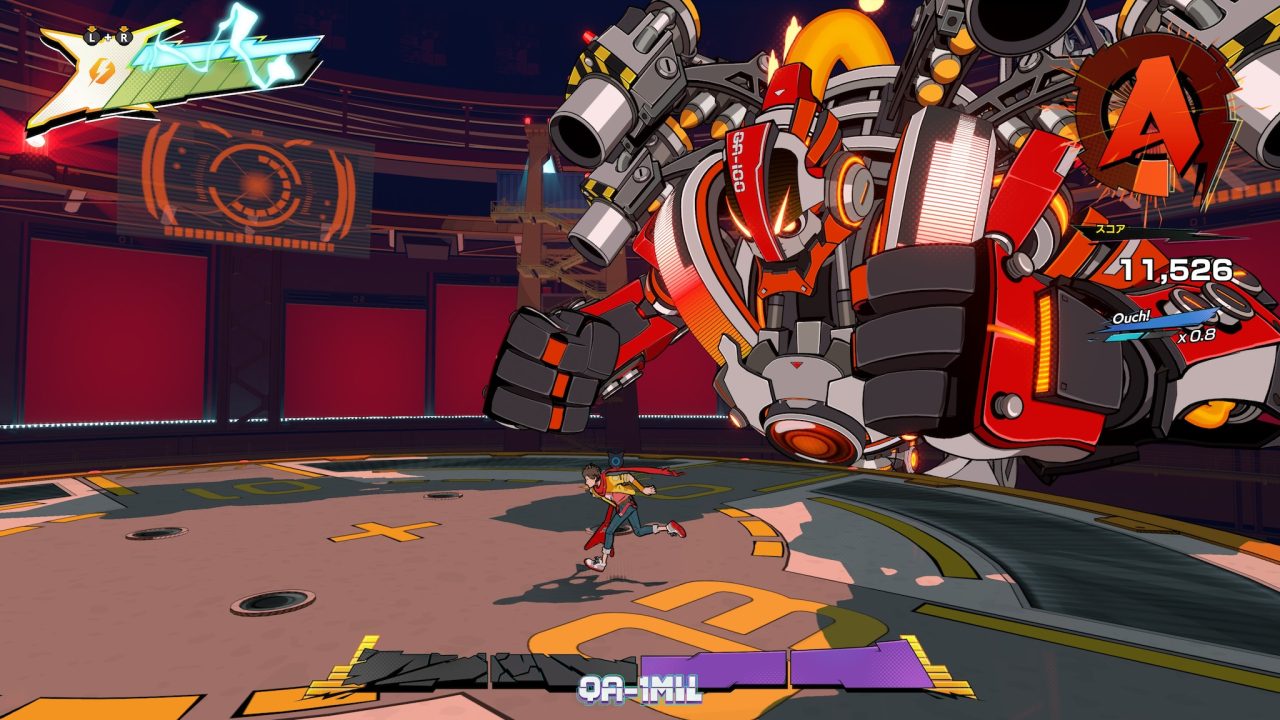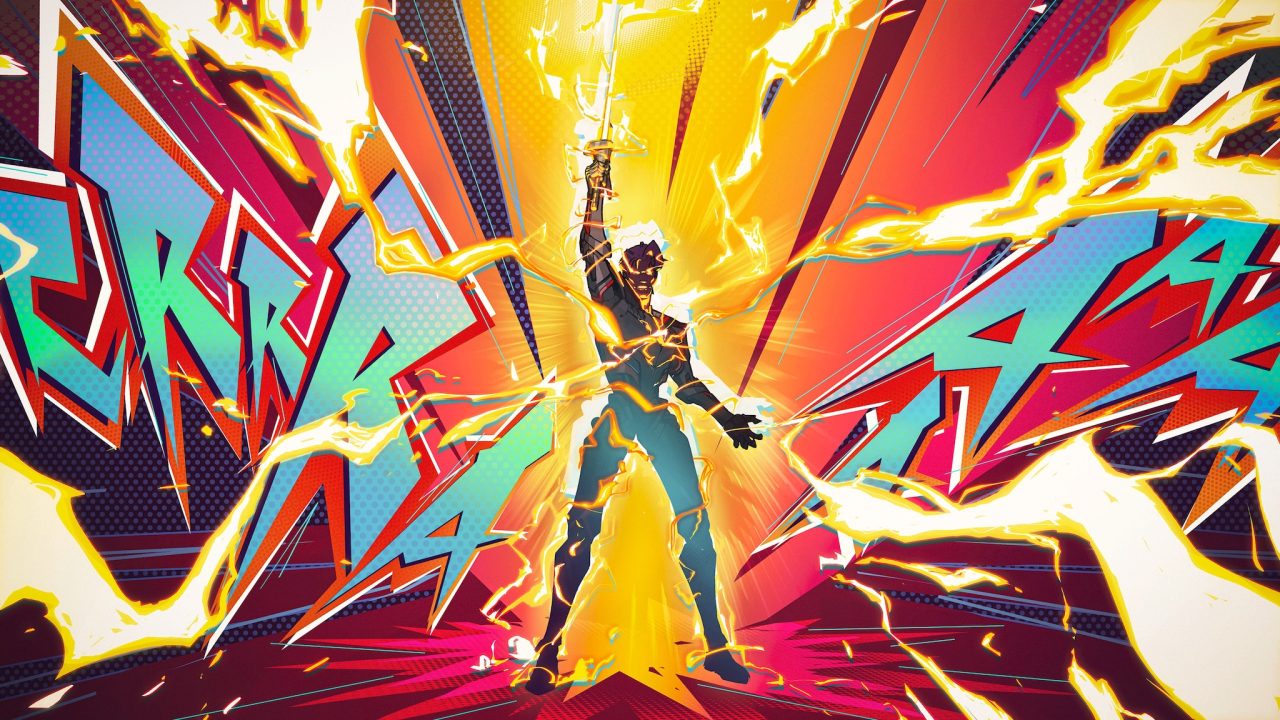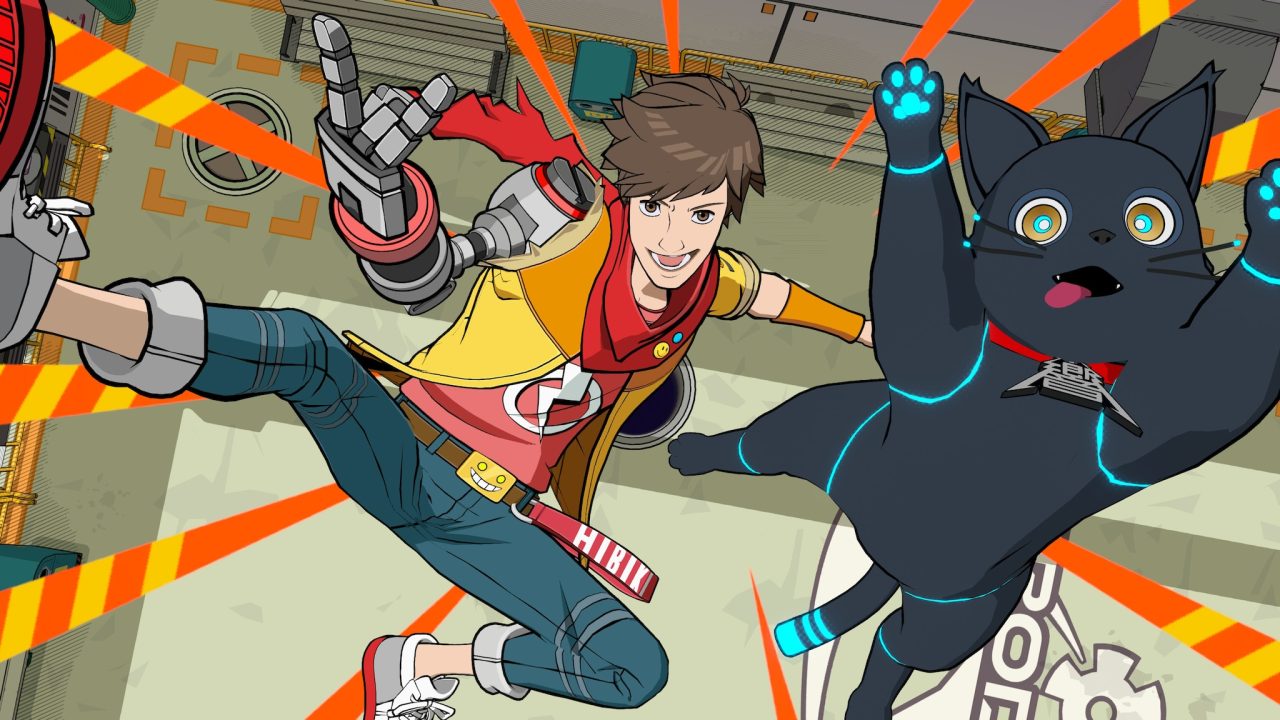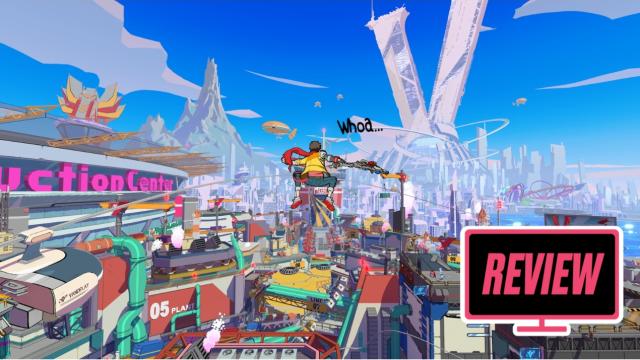For me, playing Hi-Fi Rush is like returning to a simpler time in my life. An era when I was not long out of high school, and using my own money to buy and play all the games I’d coveted but couldn’t afford. It’s a reminder of the GameCube and PS2 era’s greatest flights of fancy, games that did a lot with very little, but lingered in the memory more than some much heavier hitters.
The DNA of early 2000s games like Viewtiful Joe, Jet Set Radio, Okami, and Devil May Cry run in its veins. Anime of the era like FLCL and Beck are clear inspirations. Even the game’s alt-rock soundtrack, seemingly pulled from the Hottest 100 of 2004, evokes a specific time and place through bands like The Prodigy and The Black Keys. It defies all the genre conventions of major video games from major publishers in 2023. It isn’t an open world, it’s linear and highly curated. It isn’t crammed with mechanics, just a tight selection from which it wrings a lot of value. It doesn’t bore you with long cutscenes, only taking control from the player long enough to transfer it back to you at thrilling and surprising moments.
It has the feel of that special brand of game that flew under the radar on the GameCube: purchased on sale and owned seemingly just by you. The game that you told all your friends to play, before it vanished from memory, slowly building a cult following online, and finally taking its place as a title prized among collectors decades later.
There’s a reason for that. Masaaki Yamada, the man who designed and in some cases even directed those games, designed Hi-Fi Rush too. Indeed, a lot of the creative leads involved in Hi-Fi Rush‘s development have been around since that era. With that one piece of information borne foremost in mind, a great deal of what makes Hi-Fi Rush special immediately falls into place.
Beat ‘Em Up

Hi-Fi Rush is a third-person rhythm-based arcade brawler about a young man named Chai thrown into a cartoonish, over-the-top battle with a malignant corporation full of anime lunatics. His arm has been replaced with a robotic equivalent, full of magnets he uses to manipulate loose metal into the shape of a guitar. His heart has been replaced with an iPod full of rock music, and it dictates his circadian rhythms. Chai then uses his makeshift guitar to bludgeon his enemies in time to the music blaring in his ears. Music is Hi-Fi Rush‘s literal beating heart. Every attack, parry, and tag-in character move you make must be delivered on the beat. If you’re not terribly good at rhythm games, or you have an old TV with terrible audio-visual latency, don’t stress. Hi-Fi Rush is surprisingly forgiving in this respect. As it is in the songs that make up its soundtrack, the beat is propulsive. It is there to drive you forward.
Also, there’s a boss fight that let me kick the shit out of a big robot man to ‘1,000,000’ by Nine Inch Nails. I genuinely don’t know what else you want. Instant game of the year contender. It’s going on the list.
Combat is spread between the X, Y, and B buttons on your Xbox controller — X for light attacks, Y for heavy, and B for parrying. X attacks can be used on each beat, while Y attacks require a rest between beats. B parries are used in time with onscreen prompts. There’s a dash button on the right bumper, and a long-range grapple on the left bumper. As they come on board, you can tag in teammates to provide support attacks. Peppermint fires bullets from her gun that break energy shields, and Macaron breaks physical shields with powerful punches.
With these tools in hand and the rhythm of each song in your ears, you have everything you need to solve any of the game’s arena-based combat puzzles.
And you’ll be solving a lot of them. As stated, Hi-Fi Rush follows a linear design that has you moving from platform sections to combat arenas in sequence. The platforming sections are where the game feels most like a product of the year 2004. Big, open areas full of jumping puzzles and moving platforms that require reasonably precise timing to move through.
One annoyance that quickly emerged in these sections was my spoiled 2023 gamer brain insisting that Hi-Fi Rush has a mantle mechanic. I felt like Chai should have the ability to pull himself onto ledges that are above him. Hi-Fi Rush does not have mantling though, and it reminded me what a forgiving little crutch it has become in modern game design. Hi-Fi Rush says no. Get up here with an eight-foot vertical leap or don’t get up here at all, you coward. I respect that.
I cannot believe how good it looks

The other side of Hi-Fi Rush is its aesthetic. This is a game that, through what can only be sorcery, has the look and feel of an anime in motion. That it accomplishes this in-engine, and without compromising on it a jot as it flits between gameplay, in-engine cutscenes, and cinematics is a marvel of modern game design.
When we think of games or character models designed to look like anime shows or characters, we think of games like Dragon Ball Z Kakarot. Before now, Kakarot was the closest I’d ever seen a game get to replicating the look and feel of its source material. At the other end of the spectrum, you have Fortnite‘s attempts at recreating anime characters in the Unreal Engine. In Fortnite‘s case, the results are very hit-and-miss. Hi-Fi Rush nails its complex aesthetic on every level. Models are vibrant, and animations are exaggerated and expressive to match the story’s chaotic, cartoonish tone.
When the game wants to really turn it on, it smashes its visuals and its mechanics together in ways I’ve never seen other games accomplish. I show people screenshots and they say, “that’s an anime,” or “that’s got to be from a cinematic,” and I pound the table and say NO. It’s in-game.
Sorcery.
The look is so cleanly unified across every form of presentation that it’s occasionally difficult to spot the transitions. It’s difficult to describe and remarkable in action. The entire art and visual design team are to be commended. This is best-in-class stuff.
Game Pass and the art of the shadowdrop

Hi-Fi Rush doesn’t happen without Game Pass. Of that, I’m certain. There was no marketing campaign for this game. No-one even knew it was coming until the Xbox marketing machine began to spring leaks in the days ahead of the Developer Direct showcase. By the time the showcase ended, it was live on Game Pass and available for anyone with a subscription to download and play.
The surprise shadowdrop strategy works like gangbusters for Nintendo, so it isn’t a surprise to see Xbox do it too.
That’s not the miraculous part, though. The miraculous part is that this game got made at all. To make a game like this is to take a huge risk. It’s so different from anything else on the market right now, and from anything else that Tango Gameworks has ever made. It’s also wildly different from anything its publisher Bethesda has ever produced. But in the incubator of Game Pass, the risk is lessened for everyone. Bethesda can take a financial punt, the studio can embark on what is plainly a passion project, the platform gets a unique new exclusive, and the players get something that properly blows their hair back. Everybody wins.
And if it had been subject to the usual marketing hype machine that rules the video game industry, we wouldn’t be talking about it the same way. It would have been sold as something it wasn’t, and people probably would consider it dated rather than a fun and deliberate throwback.
What I’m saying is, I have never seen a clearer demonstration of the value inherent in a platform like Game Pass than Hi-Fi Rush.
Hi-Fi Rush is this year’s first, serious must-play. It is a dazzling throwback to the glory days of GameCube and PS2-era brawlers. It is a game that works every single second to thrill and delight the player. It’s on PC, it’s on Xbox, and it’s on Game Pass.

Leave a Reply